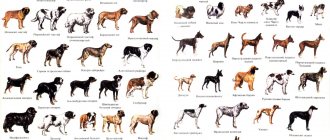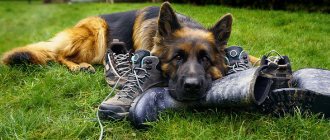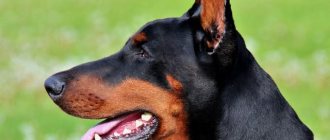1) Miniature guide horses
Like many other animals, horses can vary in size. Horses that are less than 1 meter tall are called miniature horses.
, and they differ from
the ponies
. Mini horses are actually just dwarf copies of regular horses with all the proportions of the body and limbs preserved. They can be trained to act as guide dogs for blind people, just as guide dogs typically do.
Horses have several advantages over dogs. Horses are essentially herd animals, so they will stay close to their owner instinctively. They won't be distracted by cats and birds, and they won't run through a red light if they smell cooking meat across the street. Horses live longer than dogs and can be trained to do things that dogs normally cannot do, such as approaching a traffic light at an intersection so they can press the green button. In addition, some Muslims disdain dogs, considering them dirty animals, and therefore do not want anything to do with them. They don't have the same problems with horses.
However, in addition to the advantages, guide horses also have disadvantages. Horses eat more than dogs, so if you're considering purchasing one, you'll need to factor in the cost of it, and you'll also have to clean up after it more than you would a dog. They are quite shy and are also more difficult to transport than dogs.
Links[edit]
- ↑
Harrison Eustis, Dorothy (November 5, 1927).
"The Seeing Eye" Saturday Evening Post
: 43. - "Frequently Asked Questions About Service Animals and the ADA". www.ada.gov
. - ^ abcdef "2010 ADA Revised Requirements: Service Animals". US Department of Justice. July 12, 2011
- "The World of Guide Dogs". International Association of Guide Dog Partners. Retrieved October 17, 2007.
- https://www.transportation.gov/sites/dot.gov/files/docs/P3.SA_.HUD%20Matrix.6-28-6.pdf
- "14 CFR Part 382 Disability Nondiscrimination in Air Travel" (PDF). Department of Transport
. Archived from the original (PDF) on December 24, 2016. Retrieved December 3, 2013. - "Fact Sheet #6: Right to Emotional Support Animals in Pet-Free Housing" (PDF). Bazelon Center for Mental Health Law
. Retrieved October 24, 2013. - ↑
Brennan, Jackie S. (2014). The Book of Service Animals (PDF). Southwest ADA Center. - "Frequently Asked Questions About Service Animals and the ADA".
- "Decreto No. 5904". planalto.gov.br. 2006-09-22. Retrieved June 27, 2012.
- "Acts Enacted - Queensland Legislation - Queensland Government" (PDF).
- "Canada - Alberta - Service Dog Law". animallaw.info. 2009-01-01. Retrieved June 27, 2012.
- "Helping Hands". MonkeyHelpers.org. Retrieved January 23, 2018.
- "Horse Guide". GuideHorse.org. Archived from the original on October 17, 2007.
- "Service Animals". Hidden hollow miniatures
. Retrieved May 18, 2022. - "Miniature horses for the blind". Guide Horse Foundation. Retrieved May 18, 2022.
- "Guide Horse Foundation". Guide Horse Foundation. Retrieved May 18, 2022.
- "Monkey Helpers Land 'Helping Hand'". Archived from the original on September 27, 2006. Retrieved August 14, 2006.
- "Highlights of the Final Rule Amending the DOJ Regulation Implementing Title II of the ADA". United States Department of Justice, Civil Rights Division. Retrieved October 2, 2013.
- "Testimony from the AVMA Director of Animal Welfare on the Captive Primate Safety Act". American Veterinary Medical Association. Retrieved October 2, 2013.
2) Chimney sweep ferrets
If you are organizing concerts, building giant computer networks or installing telephone systems, the most important thing is to correctly route all the necessary wires through the installed pipes. It’s not so easy to insert a wire into a huge 10-meter pipe, so it’s time to use your imagination and come up with an unusual way out of the situation. Or, for example, just tie all the necessary wires to the ferret and send it through the pipe. The beast will quickly extend the necessary wires to another exit.
Who ever thought of this, you ask. It turns out, the US Space Command! In 1999, during the construction of a missile warning center, the organization "hired" Misty the ferret to lay the wires, who was forced to run cables through 12-meter pipe systems to complete the structure.
Moreover, these furry creatures can not only guide wires through pipes, but also clean them! Take, for example, a giant particle accelerator. This facility uses hundreds of meters of pipes through which particles pass at incredible speeds and these pipes must be perfectly clean. Not a single particle of dust should get into them, otherwise even one speck of dust can block the path of subatomic particles. Cleaning that many pipes requires an investment of thousands of dollars, but in the 1970s the National Accelerator Laboratory spent just $35 to buy Felicia the ferret, who not only was hired unofficially, but also did not require payment for the work. Felicia ran through the pipes with a “mop” with a special solution tied behind her, leaving behind a perfectly clean space.
3) Coconut collecting monkeys
Collecting coconuts is not an easy job. They grow very high on huge palm trees, and collecting them at such a height without special equipment is extremely dangerous and therefore expensive. Workers in India began to refuse such work, so the coconut industry was left in a virtual stalemate until the Indian government offered a reward to anyone who could come up with a safe coconut harvesting machine. Moreover, they were sure that, most likely, this would be a machine that would simply shake the trees. No one was able to invent such equipment, but a very unconventional solution was found: to hire monkeys to collect coconuts.
Farmers began training monkeys to climb palm trees and throw cokes. These animals are accustomed to climbing trees, it is not difficult for them, and if you train them to pick and throw nuts, it is much cheaper and less dangerous than hiring people for this work. For comparison: a person is able to collect about a hundred nuts in a day, while a monkey can collect 500-800.
The idea of hiring monkeys to harvest crops is used not only in India, but also in Thailand. Moreover, monkeys began to help humans a long time ago. Training monkeys to collect nuts lasts from 3 to 6 months, during which time they are taught to collect nuts, throw them and even ride a tricycle. Moreover, monkey owners must treat the animals well, otherwise they will not work if they do not like something. One monkey took revenge on his cruel owner by killing him with a coconut.
Hunting breeds
The Laika is considered a universal dog for hunting. With it you can go hunting wood grouse, wild boar, and even bear. It is important not to use a dog that is trained to hunt small animals when hunting large animals, and vice versa. There are many types of huskies, and each is good for certain purposes. The Karelo-Finnish Laika has the ability to hunt upland game, the Russian-European Laika is suitable for fur-bearing animals, the West Siberian Laika is suitable for waterfowl, and with the East European Laika you can safely go in search of ungulates.
Hound breeds are tireless pursuers. Their task is to chase the animal until the hunter shoots it. Persistence, tirelessness in pursuit, the ability not to lose the animal's trail under any circumstances - these are the main characteristics of this breed.
Greyhounds are the most ancient hunting dog breeds. They have long been used for unarmed hunting of hare and fox. With the help of their excellent vision and scent, these dogs find the animal, after which, having developed enormous speed, they catch up with it and strangle it.
When it is necessary to drive an animal out of a hole (fox, badger, raccoon), burrow dogs will be excellent helpers. The most common of these are Wire Fox Terriers and Dachshunds. Thanks to their small stature, they easily penetrate the hole behind the animal. The dachshund can also work both on the hare and on the black grouse.
Pointers are the most suitable types of dogs for hunting swamp, field and waterfowl. Their developed sense allows them to detect hidden game, lift it on the wing and find the dead bird after the owner has shot. Setters, spaniels, and pointers also easily cope with such tasks.
4) Pest killer spiders
There is now a high demand for organic food grown without pesticides, so farmers have to find ways to get rid of pests more naturally. Tesco, a British supermarket chain, forced all the farmers who supply them to use hordes of spiders that could rid their crops of harmful insects.
Dubbed "Nature's Choice," the project turned out to be brilliant on paper, as natural predators are much less effective at controlling pests than the pesticides that farmers mostly use. Another problem is that millions of spiders are collected along with the crops and end up on the table. Agree, it’s not very pleasant to feast on, for example, grapes when some giant poisonous spider, like a black widow, is looking at you from the bunch. After one encounter like this, you won't want to eat fresh fruit for the rest of your life.
5) Smuggler Pigeons
It has long been known that pigeons are able to carry messages from one place to another; they were often used as postmen, but some soon realized that they were capable of carrying not only letters, but also, say, something illegal. For example, drugs.
Convicts from Colombia trained pigeons to “transport” contraband to and from prison. Everything that passes through the prison doors is, of course, carefully checked, but what is sent by air is not subject to customs inspection.
The birds are given special bags filled with contraband goods and then released to the waiting criminals outside the prison walls. Prison officials can find no other way to stop the flow of contraband other than to shoot every pigeon they see. The authorities had no idea that prisoners were exchanging illegal goods in this way until the police caught one such pigeon stuffed with contraband.
Of course, Colombian prisoners are not the only ones in the world who use the services of pigeons to smuggle contraband. The crew of an oil platform off the coast of Norway found an emaciated pigeon on the deck with 5 grams of marijuana tied to its legs. Delighted oil workers used the find for its intended purpose to brighten up their boring life on the platform. Pigeons are also used in South Africa to smuggle diamonds.
Reinforcement, reflexes, baiting
The internal affairs bodies use dogs and horses, in the mountainous regions - donkeys, in the southern and northern regions - camels and deer, respectively. All except dogs perform mainly transport functions. The rules for the use and maintenance of dogs are established by orders of the Ministry of Internal Affairs of Russia, spelled out in section III of the Charter of the Police Patrol Service (subsection “Peculiarities of patrol service with service dogs” - paragraphs 166–185).
It is difficult to calculate the exact number of dogs, since they are distributed between different departments - the police, customs, the Ministry of Emergency Situations, the Federal Penitentiary Service and the Federal Protective Service (which also has a canine department - TD's note). Thus, in 2015, about 800 dogs worked at customs; in the Moscow metro at the beginning of the 2010s there were only 51 animals.
There are mounted police in dozens of Russian cities, the largest is in Moscow. The main task is to patrol parks, prevent crime, and maintain order at public events. The Moscow Mounted Police has 255 horses. The number of horses in the border service of the FSB of Russia is more than 1.5 thousand horses. The Presidential Regiment, which is part of the FSO, has more than a hundred horses of Russian riding and Trakenin breeds.
The Ministry of Defense has service donkeys - in the early 2010s, the department purchased 150 animals to deliver materials and food for the needs of the military.
Dogs are the most multi-tasking of all service animals. They patrol routes and guard posts in the evening and at night, and are used to inspect forested areas and urban outskirts of cities, and when inspecting residential and non-residential premises. They help with the inspection and delivery of detainees, the detention of dangerous criminals, ensuring the personal safety of citizens and public safety, and the protection of persons in custody.
Lyudmila Chebykina, retired dog handler, author of the book “Understand your friend. The Dog Behavior Handbook explains that canine training in government services relies on three types: negative reinforcement, positive reinforcement, and conditioned reflexes. Negative reinforcement depends on the dog’s capabilities - with one breed you can “break a stool,” but with another you can’t even raise your voice, says Chebykina. Positive reinforcement is more universal - a toy, a treat, affection; as well as reinforcement at the level of conditioned reflexes, for which commands are used.
By the middle of the 20th century, the main breeds in the service of the Soviet state were Airedale Terriers, Doberman Pins and German Shepherds. Since then, says Chebykina, the state has forgotten how to breed most of them. The main working breeds now are Belgian and German shepherds, powerful and fast dogs well suited for detaining and escorting criminals. Labradors are primarily used in search and rescue services because of their good sense of smell and gentleness towards people. Small dogs, such as spaniels, are often used to search for drugs - they are easier to transport and easier to enter warehouses.
Scent training, like any training, always begins with choosing a “fetch” for the dog - a favorite toy or other object to execute the corresponding command. When she gets used to the smell of her “fetch”, it is removed and she is allowed to smell someone else’s. Naturally, this other “export” can be anything - explosives, narcotics and other prohibited substances. For finding a new scent, the dog receives a treat, affection, or, in the case of the most active breeds, play.
6) Parrots “on the hunt”
Parrots were quite popular among pirates. Their ability to imitate human speech has made them entertaining pets, with some owners teaching them rap songs or swear words to entertain guests. Moreover, their ability to understand speech is particularly impressive. Moreover, criminal elements began to use this property.
Once again, criminals from Colombia began to train parrots to shout “Run, run, you will be caught!” in Spanish when they spot a man in a police uniform nearby. One such parrot named Lorenzo did an excellent job of warning smugglers when the police approached their hideout. Nevertheless, the police managed to identify the criminals.
The police raided the building where Lorenzo was located. 200 weapons were found and four criminals were arrested. It was easy for the police to deceive Lorenzo - just change into something civilian, although they managed to guess that the parrot was a spy only after the police changed into their usual uniform. The parrot endlessly repeated the “spell.”
This turned out to be not an isolated incident. Colombian authorities reported that more than 1,700 of the parrots captured were trained to "stand on the line," and that's just the ones they could identify.
7) Dogs that predict epileptic seizures
People have been using dogs as helpers since time immemorial. Dogs helped to hunt, move, herd sheep, guard property, help the blind move, and much more. However, few people know that dogs can also warn when a person may have an epileptic seizure. Moreover, they can feel it approaching in a couple of minutes or even a couple of hours.
When a dog senses a seizure coming on, it will bark, walk in circles, or lie down in front of its owner. A person who is in danger can take medicine in time or go to a safe place. Some dogs are trained to call for help if their owner is unable to do so.
Of course, many are interested in knowing how animals are able to recognize the approach of a seizure before the victim herself can feel it. But there is no answer to this question yet. It is likely that dogs sense slight changes in their owner's behavior or feel some special chemicals that are released in their body at this time, but there is no scientific evidence for this yet.
In fact, it is impossible to train a dog to recognize the approach of seizures; the dog either knows how to do it or does not know how to do it from the very beginning. Most dogs also cannot provide assistance if a person has a seizure; not all pets are capable of this.
External links [edit]
- Disabilities and Medical Conditions - TSA (Transportation Security Administration)
- "Creature Comfort" from the New York Times
- Capuchin Monkey Helpers - MSNBC
- Americans with Disabilities Act Resources
- Guide Horse Foundation
- Miniature horse as a service animal
| vte Mammals in culture | |
| vteWorking animals | ||
| ||
similar topics
| ||











